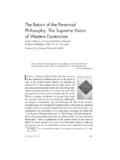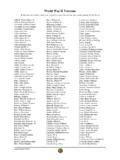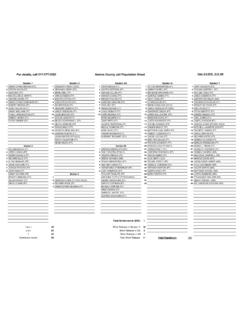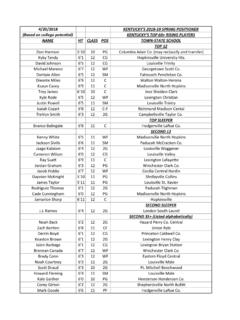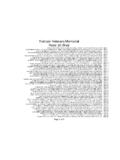Transcription of Henry Corbin - Sacred Web
1 Henry Corbin 152 Sacred WEB 23. The Corbin Trilogy: The World Turned Inside Out: Henry Corbin and Islamic Mysticism By Tom Cheetham Spring Journal Books, Conn., 2003. Green Man, Earth Angel: The Prophetic Tradition and the Battle for the Soul of the World By Tom Cheetham SUNY, New York, 2005. After Prophecy: Imagination, Incarnation, and the Unity of the Prophetic Tradition (Lectures for the Temenos Academy). By Tom Cheetham Spring Journal Books, Louisiana, 2007. Reviewed by M. Ali Lakhani T his trilogy of works centers on the metaphysical thought of the French Islamic scholar, Henry Corbin (1903 1978). A student of Scholasticism under Etienne Gilson, and a close associate of Louis Mas . signon (whose position he succeeded, as Director of Islamic Studies at the Sorbonne), Corbin was not only a pre-eminent theologian but also a mystical philosopher.
2 Influenced by the German theological tradition of Boehme, Luther, Hamann, Heidegger, and Barth, among others, Corbin developed a philosophy of mystical hermeneutics, which drew greatly from Christian and Muslim mystics and philosophers who viewed reality phenomenologically, as an unveiling of the inner Light of transcend . ent Reality. A major figure (along with Jung, Eliade, and Scholem) at the Eranos conferences, Corbin spent many years living in the Muslim world and was regarded in the West as an authority on medieval Muslim Sacred WEB 23 153. Review of Tom Cheetham's The Corbin Trilogy M. Ali Lakhani philosophy (particularly the teachings of Avicenna, Suhrawardi, and Ibn Arabi). Also, as head of the Franco-Iranian Institute in Tehran, he was a specialist in Irano-Islamic studies (particularly Suhrawardi's revival of Zoroastrian angelology), Persian Sufism (in particular, Mulla Sadra), and Shi'a theosophy (including Isma'ili gnosis and hermeneutics).
3 Corbin 's legacy has been immense, ranging from his influence upon traditional . ist metaphysicians or those with traditionalist leanings (notably, Seyyed Hossein Nasr, Toshohiko Izutsu, William C. Chittick, Sachiko Murata, Hermann Landolt, Kathleen Raine and Philip Sherrard), and extending beyond into the fields of literature and psychology (his ideas have in . fluenced, for example, the literary critic, Harold Bloom and the Jungian scholar, James Hillman). Dr. Cheetham is a scholar of Corbin , and a fellow of the Temenos Academy, which through its journal and lectures devoted to the Arts of the Imagination, and to Perennial Philosophy, both arguably key aspects of Corbin 's thought has promoted Corbin 's work for several decades.
4 Cheetham also maintains an online blog on Corbin at http://.. In The World Turned Inside Out, Cheetham has provided perhaps the best available introduction to Corbin 's thought for the general reader. The second and particularly the third volumes of this trilogy, Green Man, Earth Angel, and After Prophecy, respectively, are more interpre . tive works, exploring the relevance and significance of Corbin 's ideas for our lives and the issues that confront us in the modern volumes will be of especial interest to readers of Sacred Web, given their interpretive focus. In the comments that follow, we have chosen to review the works collectively, as a trilogy, rather than individually. For readers unfamiliar with Corbin 's writings, they might do well to read the books in the order they were written.
5 For others who may be more familiar with Corbin 's ideas and this review will attempt to provide the reader with an outline of the key ideas and who wish to sample but one book in this trilogy, we would recommend the final volume which anthologizes Cheetham's lectures for the Temenos Academy. In considering Corbin 's ideas, Cheetham remarks on the astonishing variety of influences that shaped them Christian theology, Heideg . gerian phenomenology, and Islamic mysticism fused with Zoroastrian angelology; all united by a deep reverence for what in Islam is called 154 Sacred WEB 23. M. Ali Lakhani Review of Tom Cheetham's The Corbin Trilogy . the Primordial Revelation: the book of nature. Cheetham traces the early philosophical influences of Heidegger in Corbin 's hermeneutics and phenomenology, clarifying that unlike for Heidegger, whose quest for the history of Being remained situated entirely within the Western philosophical tradition, Corbin 's research extended beyond and came to be largely influenced by Irano-Islamic metaphysics, which led him in the direction of a transcendentally rooted understanding of Being.
6 As Presence an understanding based on the reality of the mundus imaginilis , the realm of the Creative reality of the ima . ginal world (Cheetham states: Corbin called it the mundus imaginilis, the imaginal world, to underscore the fact that it is not imaginary or unreal ) was central to Corbin 's worldview. This domain of reality was a median and mediating power between the sensible and the intel . lectual, the metaphysical threshold ( barzakh ) of transcendence and of immanence. By contrast, Heidegger (in George Steiner's appraisal of him) based his metaphysics on an effort to view reality as immanence without transcendence. In Cheetham's words, Heidegger tried to erect a philosophy denying the need for the category of the Person and the transcendence implicit in that Being.
7 Corbin , however, regarded Be . ing not as an escape from the particulars of mundane reality into the realm of abstraction, but as an opening into the spiritual corporeity . of Divine Presence rooted in Personhood. Corbin 's true influences in this regard were the Sufi and Shi'ite meta . physicians about whom he later wrote, including in particular,Avicenna (981 1037), Suhrawardi (1155 1191), Ibn Arabi (1165 1240), and Mulla Sadra ( 1640). Corbin was introduced to Suhrawardi's works by Massignon, and the influence on him of this twelfth-century Persian mystic was seminal. Corbin later wrote: [T]hrough my meeting with Suhrawardi, my spiritual destiny for the passage through this world was sealed. Platonism, expressed in terms of the Zoroastrian angelology of ancient Persia, illuminated the path I was seeking.
8 From Suhrawardi, the founder of the Illuminationist School of Persian mysticism, Corbin learned of the importance of the intermediary imaginal realm as the means of the visionary perception of the sacral light that was central to Zoroastrian faith and to the Abrahamic in the Zoroas . trian tradition, the Celestial Light of Ohrmazd and His six Archangels in Avestan cosmology, is opposed to the Darkness of Light is Sacred WEB 23 155. Review of Tom Cheetham's The Corbin Trilogy M. Ali Lakhani embodied for all created beings in their Fravarti or personal angel and soul's guide, and illuminates the path of the soul's personal embodiment of the Light through spiritual transformation. Similarly, the Light of God appears as the Burning Bush in Judaism, the apparitions of Gabriel to Mary and Muhammad, and as the symbolic Light upon Light of the Surah of Light in Islam.
9 These are images of the divine theophany and of the soul's destiny to actualize on earth the Energy of sacral Light . through spiritual transformation. From the Muslim texts that he studied, Corbin learned how life could be viewed as a dramaturgy , an awakening of the soul through its encounter with its archetypal image in the imago mundi with the personified presence of the soul's Heavenly Twin, its Guiding Angel or Fravarti. The soul's encounter with its Angel is to be understood here as its submission to the active Intelligence. The Angel is identified with such figures as the Paraclete in the Gospel of St. John, or Khidr in the Qur'an, with the Archangel Gabriel, and with the Logos or Angel Holy Spirit.
10 Corbin was greatly influenced here not only by Suhrawardi's revival of Mazdean angelology, but also by the Kubrawite phenomenol . ogy of lights and colors developed by the central Asian school of Sufism of Najm al-Din Kubra (1146 1220), and his followers Najmeddin Razi (d. 1256) and Alaoddawleh Semnani (1261 1336), as well as the illumi . nationist metaphysics (of illumination as the intensification of being . and inner light) associated with the Persian, Mulla imaginal . encounter with the Angel, with the light of that Presence which is the ultimate source of all personification formed the basis of the soul's individuation, its ethical valorization and its harmonization with the world. Cheetham notes: It is not too much to say that Corbin 's entire work revolves around the ontological priority of the individual.
